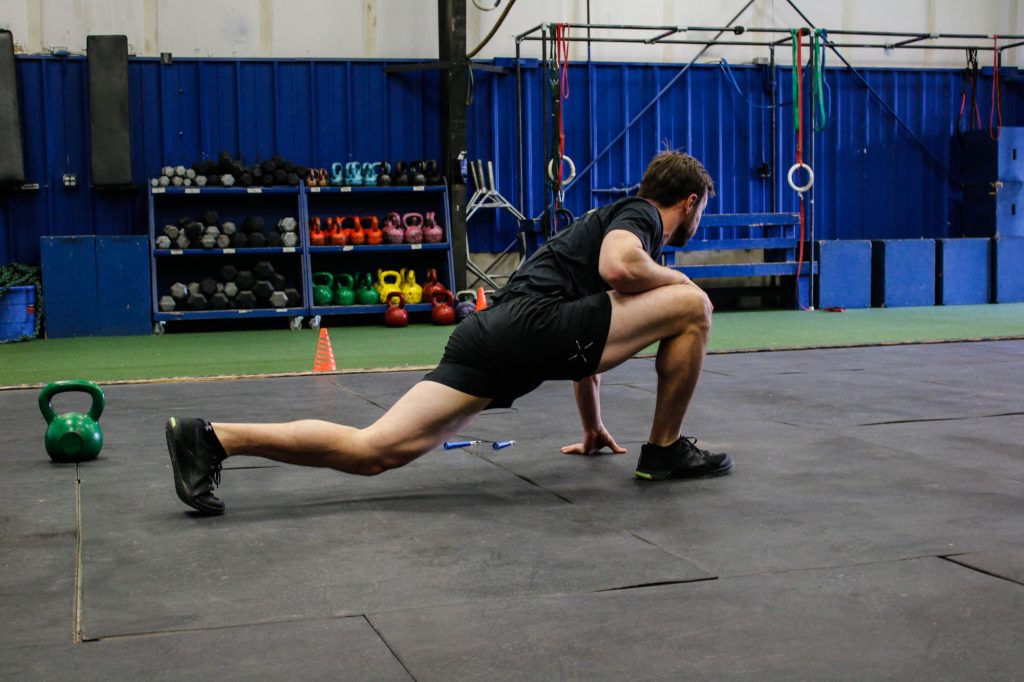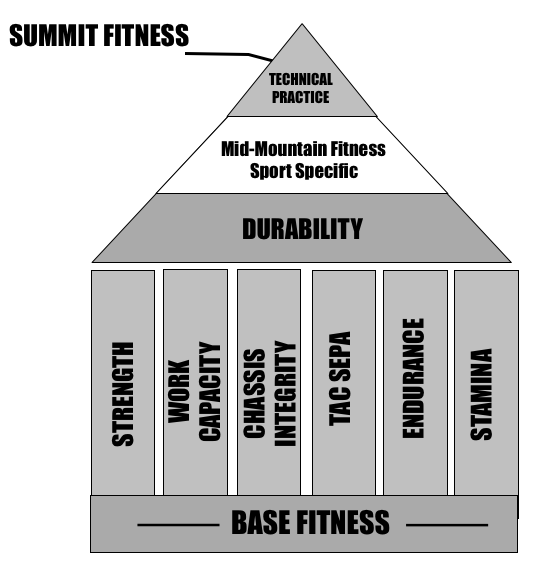
By Rob Shaul
I’ve always been somewhat of a contrarian when it comes to durability.
In the fitness world, there is an entire subset industry build around “durability.” Durability “experts” range from acupuncture practitioners to Physical Therapists, to K-Star apostles, to EXOS-trained strength and conditioning coaches.
Over the years, we’ve tried many of the detailed, specific, mobility, stabilizer strength and functional movement assessments, drills and exercises. We’ve gone so far as to develop and test our own mobility assessment and standards.
Within my own “Fitness Mountain” I originally had durability as one of the cornerstones of “Base Fitness.”
However, the longer I work with mountain and tactical athletes, the less room and space mobility and other exercises get in the training sessions I design. The stuff just hasn’t stuck.
For quiet some time, this was my durability equation:
Durability = 80% Total Body Strength + 10% Functional Movement + 10% Stabilizer Strength
Here it is today:
Durability = 99% Mission-Direct Fitness + 1% Mobility, movement, stabilizer strength, etc.
As well, I’ve changed my Fitness Mountain, removing durability as one of the cornerstones of base fitness, to an attribute that comes as the result of base fitness. Below is my Fitness Mountain for military athletes and wildland firefighters:

You’ll see how “durability” rests on top of the fitness “cornerstones” of Strength, Work Capacity, Chassis Integrity, TAC SEPA, Endurance, and Stamina.
In my opinion, solid, “mission direct” base fitness results in a high level of durability for military athletes, upon which they can build more intense, deployment, selection, or season-specific, sport specific, “mid-mountain” fitness.
My thinking is simple. If you are fit for the demands of your job, your chances of injury are greatly decreased.
For some time, Gray Cook used a study of USMC OCS candidates as validation of his Functional Movement Screen for assessing durability.
A few years ago I fell in love with the idea of the FMS as a predictor of injury potential, traveled to Phoenix for a FMS certification course, heard Cook speak, bought one of his overpriced, plastic testing kits and hurried back to Wyoming assess my athletes and wiz-bang them with the geeky assessment exercises and solid-sounding theories.
But I noticed a couple things with the FMS results. First, the second time the athletes took the assessment, their score significantly increased – even if they took it the next day. This told me the athletes’ durability hadn’t increased – they were just familiar with the assessment exercises.
Second, many of the athletes who scored highest on the FMS were the most “delicate” in terms of injury. The FMS is a fairly athletic assessment – and people who naturally know how to move their bodies in space, do well.
Over the years I’ve noticed the best natural athletes – which I define as those with the best movement in space, were likewise the most “delicate,” and most likely to miss training or mountain days due to some type of injury. I’ve come to believe that what makes these individuals move the best, also makes them delicate.
Individuals who can best move their bodies in space – good natural athletes – naturally are in better tune with their bodies than the rest of us. While this allows their great movement, it also heightens their sensitivity to their bodies when things aren’t quite right. Nicks and dings old battle axes like me brush off, sideline great athletes and send them to the massage therapist.
I like to compare these individuals to $200,000 Ferrari’s. They are super agile, fast and explosive. But in the grocery store parking lot, running into a shopping cart would put a crease in their high-tech composite side panel, sending them to the body shop.
People like me, – not super athletic and who score well below 14 on the FMS, are more like old 1979 F150’s. Our side panels are already full of dings and dents and the latest one from the shopping cart just adds character. We just keep grinding on.
Getting back to Gray Cook and his OCS study. He failed to mention in the course I took that the same study he cited as validating the FMS, found that candidate scores on the USMC PFT were even a greater determinate of durability than their FMS score. In other words, the more fit the candidate, the more durable they were. Subsequent research has further put into question the validity of the FMS as a durability assessment.
This idea has mission-direct implications. A few weeks ago I spent a day working with a wild land fire hotshot crew here in Wyoming. After some water confidence training, I gave a presentation on our fitness programming approach and noted that our wild land firefighter pre-season training plan includes plenty of ruck running and loaded running. One of the firefighters asked if I was concerned about knee and ankle injuries from all of that loaded movement.
I responded that I was pretty sure loaded running and rucking was harder on joints than unloaded movement. But, that hotshot crews never fought fires in shorts and a t-shirt, and I’d rather risk injuring someone in the mission-direct train up for wildland firefighter training than send them into the fire not fit for the job …. where the consequences of de-conditioning or injury, could be much more deadly.
Doesn’t it seem reckless that often Army units conduct only PRT prior to deployment, then wonder how come soldiers struggle with performance and joint issues when they end up downrange carrying 45-90+ rucks on patrols?
One of the confusing things about the durability industry is all of the theory behind the geeky movements and cutting-edge treatments seems so solid – just like the FMS. Often I’ll have athletes come into the gym proclaiming the healing benefits of a certain masseuse, PT, chiropractor, stretching protocol, hot/cold treatment, wonder pill or some other supplement. The repeat the theoretical argument the practitioner made to them, and it certainly seems to make sense.
They will ask my opinion. I used to argue. I don’t anymore. Now I answer, “if it works for you, keep doing it.”
A few weeks later, I’ll always circle back and ask the athlete how the treatment or supplement is going. Inevitably, they’ve stopped doing it.
The stuff just doesn’t stick.
You Might Also Like The Tyranny of the FMS
